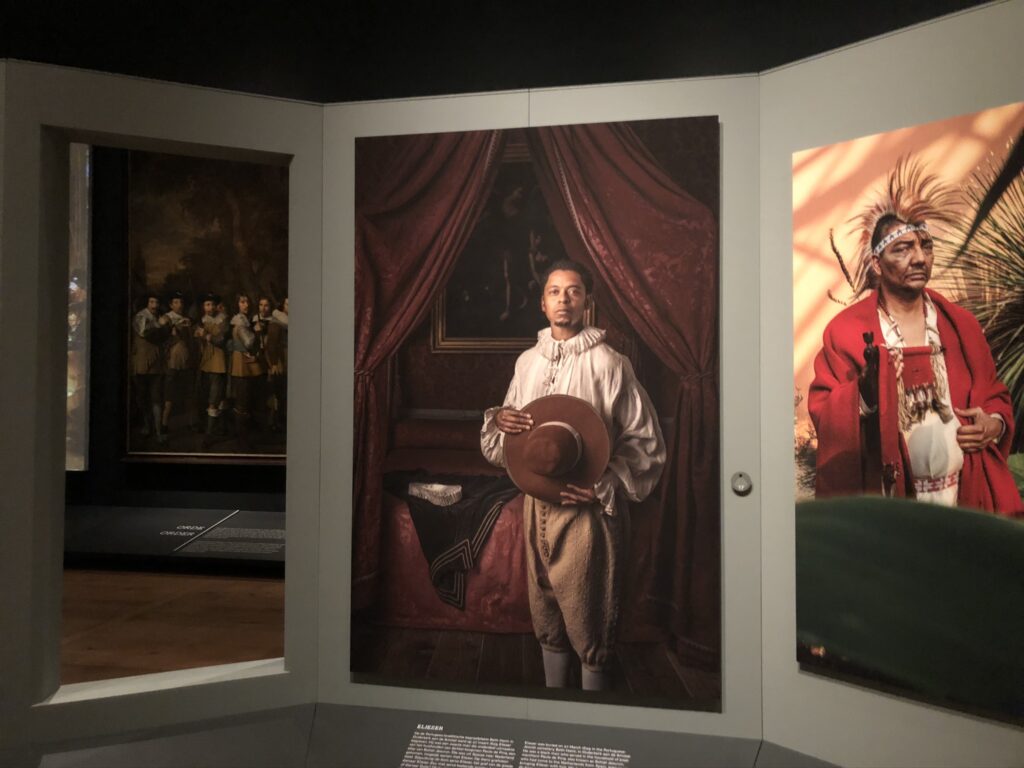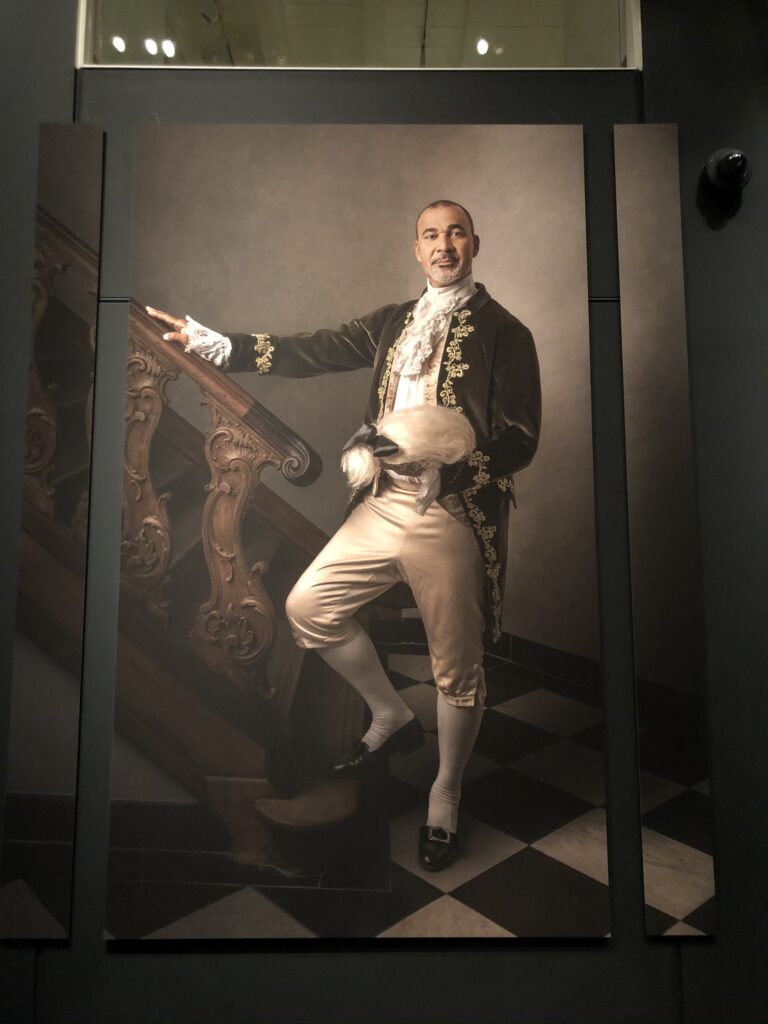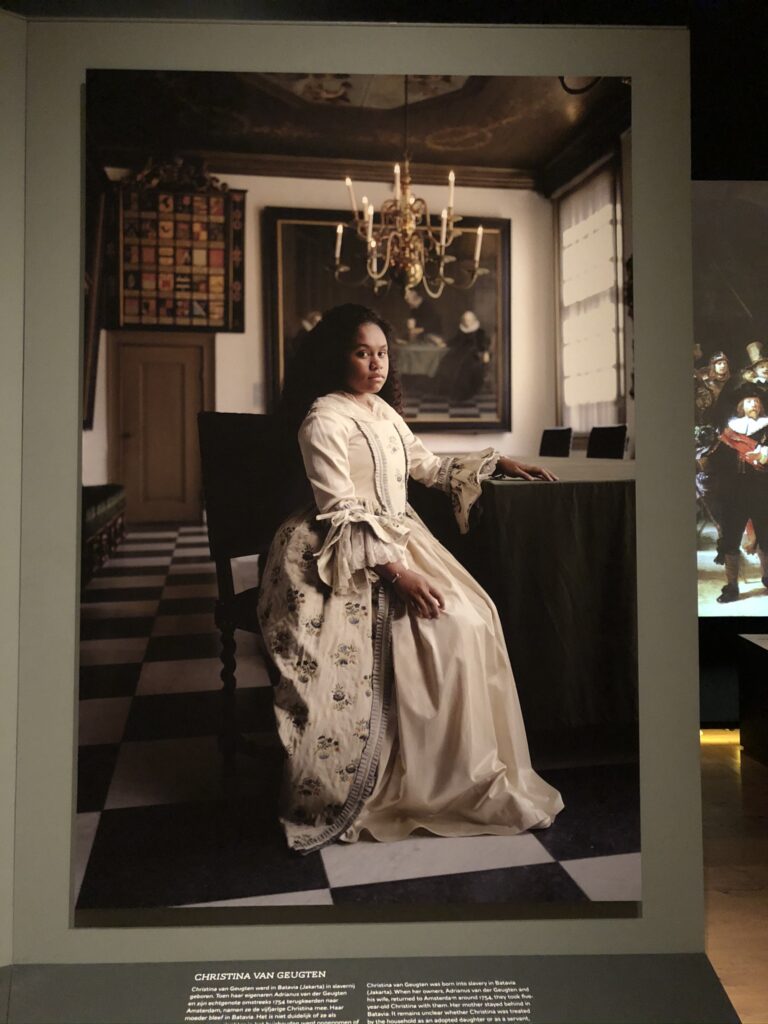Since my first visit to the Hermitage Amsterdam in 2014, I always make a small detour through the semi-permanent collection of the Amsterdam Museum wing. The exhibition Portrait Gallery of the 17th Century offers an extensive overview of the evolution of Dutch regents group portraiture.
Standing in one of the massive rooms with group portraits from the 17th century, I see, sitting around a richly decorated table, a dozen white men. Some look disdainfully at me, as if I do not belong there in the same room with them. Others seem friendlier, extending their hands, offering their glasses. Right next to this group portrait, there is a life-size photograph of former footballer Ruud Gullit, dressed as an 18th-century nobleman. And there are other photographs of people of color in this room, all dressed as forgotten persons from the Dutch Republic. These photographs are part of Dutch Masters Revisited.
In recent years, opinions on inclusivity, the nature and practices of the Dutch 17th century, and the role of the museum and its own collection, changed. Thus, the Amsterdam Museum thought it a good idea to alter the group portraits exhibition and tell not only the story of white Dutch merchants and regents but also that of some of the ‘forgotten’ people of color that lived in the Dutch Republic.

The exhibition is a collaboration between the Amsterdam Museum and Jörgen Tjon A Fong from cultural organization Urban Myth. This organization, according to the website, “puts untold stories in the spotlight”. It offers new perspectives on shared history and focuses on the Dutch history and identity. Urban Myth states that cultural diversity has always been a part of Dutch society.
The exhibition is quite a literal interpretation of Urban Myth’s goals. Their aim is to tell untold stories and to change side characters into main figures. The exhibition does exactly that. One who looks at the group portraits would assume only white people inhabited 17th-century Holland. However, historical research by Mark Ponte of the Amsterdam city archive shows that many person of color lived in the republic, as well. The creators tell the stories of these practically forgotten people who also inhabited Amsterdam and the Dutch Republic in the 17th and 18th century. Tjon A Fong wanted to re-write the historical record by putting up their pictures in the spotlight next to the group portraits of the permanent exhibition. The people that are portrayed in the exhibition were never painted by contemporaries such as Rembrandt or Frans Hals, but they should have been. By photographing prominent black ‘Hollanders’, these figures re-enter the collective history.
The goals of the Amsterdam Museum are also addressed in this exhibition. The museum wants to be more inclusive by telling previously unheard stories of marginalized people. The museum wants to be a place that is relevant to all and where all feel welcome. That is why the Amsterdam Museum self-critically reassesses its own collections, the methods they use, and the stories and presentations on Amsterdam and its citizens. The museum stated that there will be more exhibitions like Dutch Masters Revisited.

Whereas the permanent exhibition tells the narrative of the Dutch ‘Golden Age’, Dutch Masters Revisited places the photographs of people of color next to, and opposite of, the group portraits. Here, a clever instance of juxtaposition arises. There is a triptych of two photographs and with one window open so we can see the group portraits in the back – it is cleverly done. Put in the same space as the group portraits of Dutch regents, the photographs are a form of ‘writing back’ and they provide a counter-narrative to the narrative that is already being told in the permanent exhibition.
Curator Tjon A Fong and photographer Humberto Tan were guests in the popular TV show De Wereld Draait Door on September 12th, 2019. In a 13-minute long item they talked about their aims and about the problems they faced while photographing the people in places like the Rijksmuseum and the Museum Van Loon. It was more of a celebratory interview rather than a critical approach, but that is how De Wereld Draait Door works.
Newspaper NRC Handelsblad reviewed the exhibition together with the HERE: Black in Rembrandt’s Time exhibition at the Rembrandthuis. The review is focused mainly on the latter exhibition, but Dutch Masters Revisited is praised for saving Afro-Amsterdammers from oblivion. It received five out of five stars.
De Volkskrant published an article on the opinion page by the director of the Amsterdam Museum and the curators of Dutch Masters Revisited. In this piece, they talk about making the museum more inclusive and adopting a self-critical approach. The same paperalso published an interview with artistic director of the Amsterdam Museum, Margriet Schavemaker. On the exhibition, she states that Tjon A Fong gave the portraits a face and a story. Thus, presenting a richer image of history.
Kunstkrant, Het Parool, and other newspapers and (art) historical websites and magazines have also published articles on the exhibition, without exception, the Dutch reviews are all very positive. The New York Times briefly mentions the exhibition in an article on Dutch museums and the legacy of colonialism and slavery.

Dutch Masters Revisited is an excellent example of shared history. The Amsterdam Museum and Jörgen Tjon A Fong from Urban Mythworked together in creating an exhibition that is in dialogue with the permanent collection. Photographs of prominent Dutch people of color blend in perfectly with the surrounding group portraits. Moreover, the exhibition sheds light on an almost forgotten history of people of color that lived in Amsterdam in the 17th and 18th century. Amsterdam Museum and Urban Myth have more projects in the pipeline. I look forward to the next installment of their partnership.
Jan Steinz